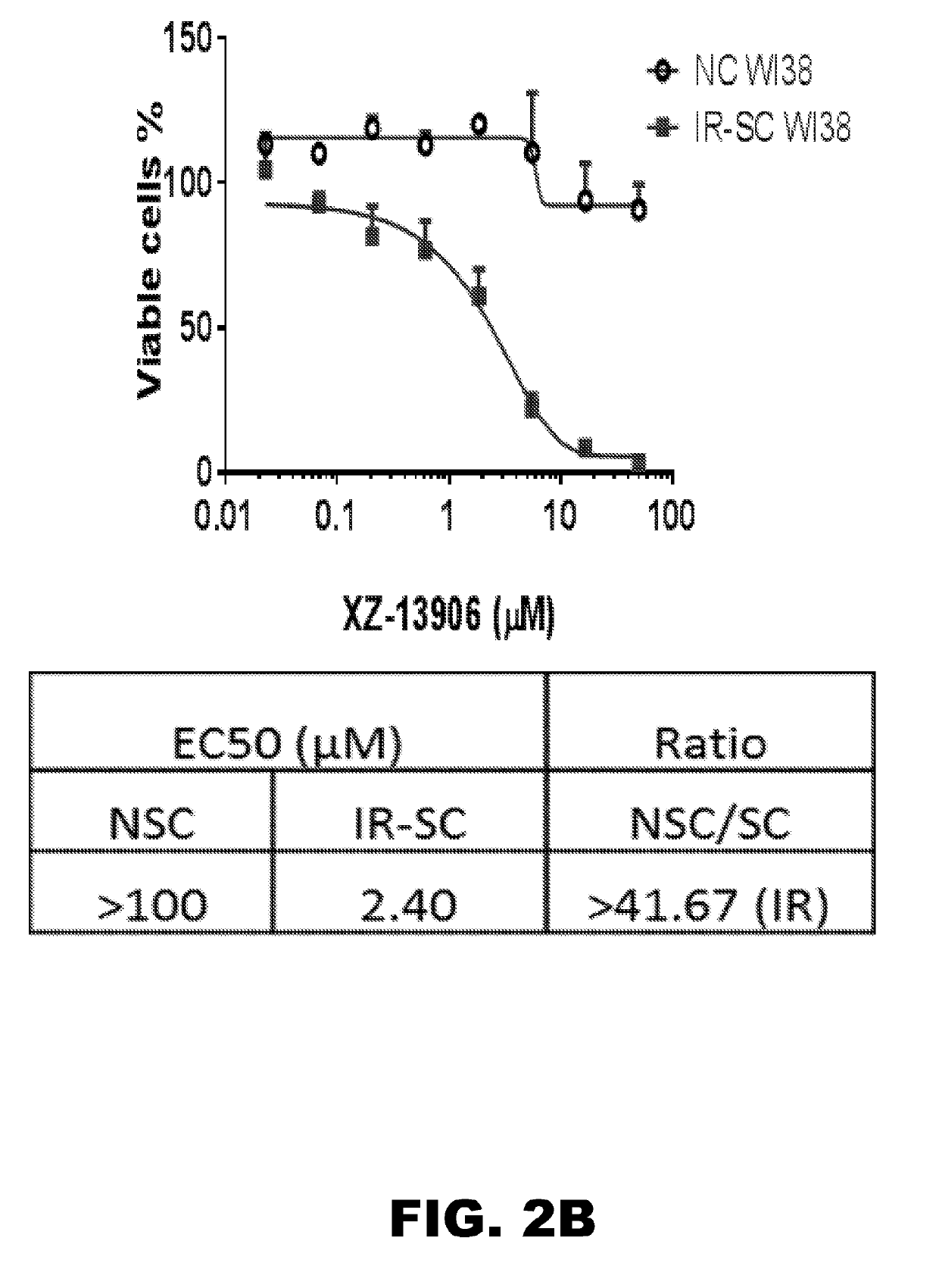Compounds that induce degradation of Anti-apoptotic bcl-2 family proteins and the uses thereof
a technology of bcl-2 and family proteins, applied in the field of compounds that induce the degradation of bcl2 family proteins, can solve problems such as tissue degradation and loss of function
- Summary
- Abstract
- Description
- Claims
- Application Information
AI Technical Summary
Benefits of technology
Problems solved by technology
Method used
Image
Examples
example 1
of XZ-13906
Preparation of (4-bromo-2-fluorophenoxy)(tert-butyl)dimethylsilane (2)
[0195]
[0196]4-Bromo-2-fluorophenol (1.0 g, 5.24 mmol), TBSCl (1.03 g, 6.83 mmol) and imidazole (713 mg, 10.48 mmol) were dissolved in 20 mL DMF and the mixture was stirred at room temperature for 16 hours. Water was added to the reaction mixture and extracted with EtOAc. The combined organic phases were washed with water x1, brine x1, dried over Na2SO4, filtered and evaporated to dryness. The resulting oil was further purified by column chromatography to afford 1.60 g compound 2 as colorless oil. Yield 100%. 1H NMR (400 MHz, CDCl3) δ 7.22 (dd, J=10.1, 2.4 Hz, 1H), 7.15-7.07 (m, 1H), 6.79 (t, J=8.7 Hz, 1H), 1.00 (s, 9H), 0.19 (d, J=0.9 Hz, 6H) ppm.
Preparation of tert-butyl 4-(prop-2-ynyl)piperazine-1-carboxylate (4)
[0197]
[0198]1-Boc-Piperazine 3 (1.0 g, 5.38 mmol), 80% 3-bromoprop-1-yne toluene solution (900 μL, 8.07 mmol), and DIPEA (1.78 mL, 10.76 mmol) were dissolved in 25 mL DCM and the mixture was s...
example 2
of XZ-13942
[0212]
Preparation of ethyl 5-(3-azidopropyl)-2-(8-(benzo[d]thiazol-2-ylcarbamoyl)-3,4-dihydroisoquinolin-2(1H)-yl)thiazole-4-carboxylate (14)
[0213]
[0214]Compound 10 (100 mg) and NaN3 (13 mg) were stirred in 5 mL DMSO at 45° C. overnight. The mixture was poured into water and extracted with EtOAc. The organic phase was washed with water x1, brine x1, dried over Na2SO4, filtered and evaporated to dryness to give 85 mg pure product as white solid. Yield 98%. 1H NMR (400 MHz, CDCl3) δ 7.82 (d, J=6.7 Hz, 1H), 7.54 (d, J=7.6 Hz, 1H), 7.35-7.26 (m, 4H), 7.18 (t, J=7.6 Hz, 1H), 4.87 (s, 2H), 4.28 (q, J=7.1 Hz, 2H), 3.90-3.79 (m, 2H), 3.31 (t, J=6.6 Hz, 2H), 3.11 (t, J=7.4 Hz, 2H), 3.03-2.92 (m, 2H), 1.98-1.82 (m, 2H), 1.31 (t, J=7.1 Hz, 3H) ppm.
Preparation of methoxymethyl 5-(3-azidopropyl)-2-(8-(benzo[d]thiazol-2-ylcarbamoyl)-3,4-dihydroisoquinolin-2(1H)-yl)thiazole-4-carboxylate (15)
[0215]
[0216]Compound 14 (85 mg) and NaOH (26.5 mg) were stirred in a mixture of ethanol and wate...
example 3
of XZ-14424
[0219]
Preparation of 2-(2,6-dioxopiperidin-3-yl)-4-((2-(2-(prop-2-yn-1-yloxy)ethoxy)ethyl)amino) isoindoline-1,3-dione (18)
[0220]
[0221]Compound 7 (107 mg), amine 17 (84 mg), and DIPEA (193 μL) in 5 mL DMF were stirred at 85° C. for 16 hours. Water was added to the reaction mixture and extracted with EtOAc. The organic phase was washed with water x1, brine x1, dried over Na2SO4, filtered and evaporated to dryness. The resulting mixture was purified by column chromatography using EtOAc and hexanes as eluents to afford 50 mg compound 18 as a green solid. Yield 32%. 1H NMR (400 MHz, CDCl3) δ 7.98 (s, 1H), 7.62-7.35 (m, 1H), 7.11 (d, J=7.1 Hz, 1H), 6.93 (d, J=8.5 Hz, 1H), 4.92 (dd, J=11.9, 5.3 Hz, 1H), 4.21 (d, J=2.3 Hz, 2H), 3.78-3.66 (m, 6H), 3.49 (t, J=5.4 Hz, 2H), 2.93-2.68 (m, 3H), 2.48-2.41 (m, 1H), 2.18-2.09 (m, 1H) ppm.
Preparation of methoxymethyl 5-(3-(4-(3-(4-(4-azidobutanoyl)piperazin-1-yl)prop-1-yn-1-yl)-2-fluorophenoxy)propyl)-2-(8-(benzo[d]thiazol-2-ylcarbamoyl)-...
PUM
| Property | Measurement | Unit |
|---|---|---|
| Molar density | aaaaa | aaaaa |
| Molar density | aaaaa | aaaaa |
| Molar density | aaaaa | aaaaa |
Abstract
Description
Claims
Application Information
 Login to View More
Login to View More - R&D
- Intellectual Property
- Life Sciences
- Materials
- Tech Scout
- Unparalleled Data Quality
- Higher Quality Content
- 60% Fewer Hallucinations
Browse by: Latest US Patents, China's latest patents, Technical Efficacy Thesaurus, Application Domain, Technology Topic, Popular Technical Reports.
© 2025 PatSnap. All rights reserved.Legal|Privacy policy|Modern Slavery Act Transparency Statement|Sitemap|About US| Contact US: help@patsnap.com



